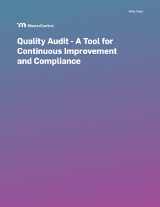
GxP Lifeline
Overcoming the Top 5 Pitfalls in Medical Device Quality System Auditing
Ignoring U.S Food and Drug Administration (FDA) requirements for inspections does not make them go away, even the internal ones. Audits are integral to verifying compliance but additionally offer findings that can improve processes and products. Unfortunately, many medical device firms fail to comply with medical device audit regulations or assume an adversarial position. Consequently, they miss the benefits of consistent, targeted audits as well as the collaborative intentions of inspectors themselves.”
The FDA’s current Compliance Policy Guide states that firms not under investigation that have FDA audit quality assurance measures in place, and are conducting audits accordingly, will not be subjected to having audit records reviewed or copied. 1 The FDA’s intention is to encourage firms to conduct inspections and audits that “are candid and meaningful.”2
Some critical questions to ask while planning medical device audit management activities are:
- How can we make self-auditing easier and proactive?
- How can we reduce the number of external audits due to nonconformances?
- How can we consistently be prepared for audits, scheduled or not?
- How can we shorten inspection times?
- How can we tap into the “deep data” that’s available in audit findings?
Common Compliance Challenges in Quality System Auditing
The FDA allows medical device firms to establish their own quality system elements as long as they fit within the larger umbrella of FDA quality assurance requirements. Sometimes this flexibility makes it difficult for firms to manage the “responsibility for meeting these requirements and for having objective evidence of meeting these requirements.”3
This is a list of five common problem areas with medical device quality system auditing identified by investigators:4
1. Procedures and Scope.
No internal or informal audit checklists are outlined, or the scope does not challenge the system in terms of sample size, time frame, and record review. Inadequate audits look only for the existence of procedures and records, but not the accuracy or completeness of records; or fail to follow the firm's own requirements.
2. Schedules
No audit schedule is established; the schedule, or any changes to it, was not approved; or the schedule is not followed.
3. Documentation.
Firms fail to record the results of any informal audits or the reasons for audit procedure deviations. Audits fail to review documents for accuracy or completeness because firms are limited to unstructured data buried in paper documents.
4. Training.
Poor auditor training or no evidence of training. Auditors are inspecting their own areas creating a conflict of interest. Short-staffed companies do not have enough employees trained in quality assurance (QA) to complete device history record (DHR) reviews.
4. CAPA and Review.
No tie-in to corrective action/preventive action (CAPA) or management review. No re-audits or changes to audit scope and schedules despite referrals to CAPA. No efficient way for stakeholders to review or sign off.
Make Medical Device Quality System Auditing Manageable
Together, inspectors and audit findings can reveal key quality indicators on which to focus. This is consistent with the top-down approach outlined in the FDA Guide to Inspections of Quality Systems.5 Choosing a quality medical device audit management software system further allows you to be audit-ready on a daily basis and able to address more serious systemic problems.
An auditing solution must adequately handle these elements that inspectors are looking at:
Nonconformances.
A primary focus of inspectors is how a firm handles incoming raw materials, in-process, and finished device nonconformances. Your system must handle nonconformances according to 21 CFR 820.90 and also let you correct mistakes that impact quality and safety. 6
Training.
Investigators are looking for adequate training and resources appropriately tasked to perform quality audits and reviews.
Documentation.
Efficiently storing, organizing, and accessing your collection of design and device records is crucial to being audit-ready all the time. Implementing a digital paperless solution enables an organization to automate and maintain complete and accurate electronic production records.
Reporting and Risk Management.
Your solution should help you to dig into deep data, such as root causes, high nonconformances, CAPA overwhelm, and other patterns.
CAPA and Review.
An enterprise solution lets you connect audit findings to design, manufacturing, CAPA, training tasks, and other quality processes in order to make timely corrections. Review by exception capability is a crucial time-saver in this area.
When used efficiently, audits can lead beyond compliance to improved performance. Getting a handle on regularly scheduled audits that adequately investigate the key components of your quality management system is a welcome relief and a justified investment strategy. Once you do, you can not only correct course as needed but set your course in line with desired outcomes and continuous improvement efforts.
The information in this blog is largely based on an interview conducted by MasterControl with Lori A. Carr, a former medical device specialist with the FDA's Office of Regulatory Affairs (ORA). 7
References:
- "" CPG Sec. 130.300 FDA Access to Results of Quality Assurance Program Audits and Inspections,"" DA, June 2007.
- Supra Note 1
- “Quality System (QS) Regulation/Medical Device Good Manufacturing Practices,” FDA, Feb. 23, 2022.
- “Q&A: FDA Medical Device Investigator Offers Insights on Inspection,” MasterControl, 2006.
- “Guide to Inspections of Quality Systems (QSIT),” FDA, Aug, 1999.
- “Guide to Inspections of Medical Device Manufacturers, Section 5. Nonconforming Product - 21 CFR 820.90,” FDA, current as of Sept. 4, 2014.
- ""Q&A FDA Medical Device Investigator Offers Insights on Inspection,"" MasterControl, 2006.
Free Resource

Enjoying this blog? Learn More.
Quality Audit – A Tool for Continuous Improvement and Compliance
Get the guide